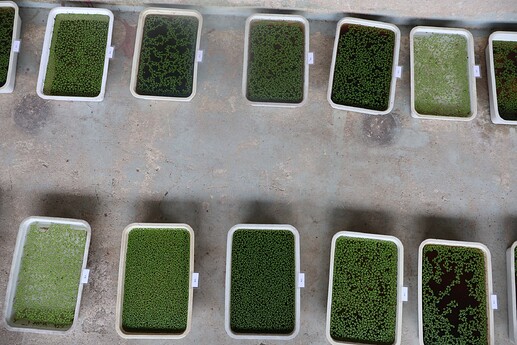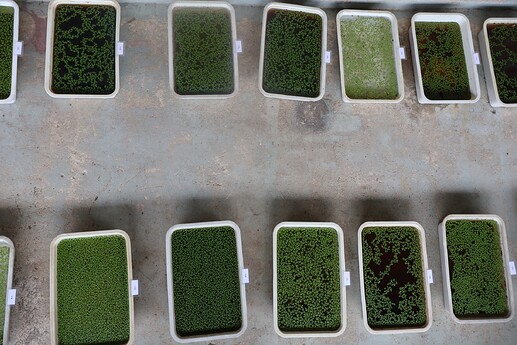Growth rate of duckweed update
ECHO interns Nitin Rex Sancho and Rebekah Hepner recently conducted trials on the growth rate of duckweed and azolla under different fertility treatments and light levels. While the azolla showed too much volatility to draw conclusions, the duckweed showed a clear trend. This update gives a brief overview to resolve this thread. A full description of the research will be made available elsewhere on ECHO Community.
Design:
Ten fertility rates were prepared by mixing Cow Dung Slurry (CDS) and soil. Tubs were prepared with the different solutions, with three replicates per solution rate. There was a total of 30 tubs per trial. In the first trial, there was 98% of solar radiation was shaded, while in the second there was 72% shading. Five grams of duckweed was added to each tray.
To prepare the solutions, 5 kg of dried cow manure was mixed with 50 liters of water, and left to soak for 5 days. The manure was filtered out, and the remaining CDS diluted for use in different treatments. Some treatments also had a 2cm layer of soil added at the bottom of each tub. These rates are presented below.
| Treatment |
Treatment details |
| T1 |
Control : 0 % CDS+ Soil |
| T2 |
Control : 0% CDS + Without Soil |
| T3 |
5%CDS+ Soil |
| T4 |
5%CDS + Without Soil |
| T5 |
10%CDS+ Soil |
| T6 |
10%CDS + Without Soil |
| T7 |
15%CDS+ Soil |
| T8 |
15%CDS + Without Soil |
| T9 |
20%CDS+ Soil |
| T10 |
20%CDS + Without Soil |
Results
The low light conditions grew very slowly, and there was little difference in yield across the fertility treatments. In the high light conditions, there were large differences in average growth rates across the treatments.
In Graph 1 below, you can see that at high light levels, additional Cow Dung Slurry concentrations increases the growth rate of the duckweed.
Graph 1
In Graph 2 below, we can see that when the Cow Dung Slurry was mixed with a constant rate of soil, the trend of increased growth with increasing CDS % disappears. The growth rates of the lowest CDS% treatments matched that of the highest CDS % solutions without soil.
Graph 2
Conclusions
When light is the main limiting factor, the fertility of water duckweed grows in is not a limiting factor even at very low fertility levels. As light levels increase towards the optimum level for duckweed growth, duckweed will require higher levels of fertility.
Dissolved soil may be able to be used as a fertilizer for duckweed without animal manure.
When using Cow Dung Slurry as a fertilizer for duckweed, it is likely that the optimum rate for duckweed growth (following preparation techniques used in the trial) is 20% or higher. The optimum rate will depend on the growth potential of duckweed given light and temperature conditions.



